Wisconsin Plastics, Inc. Case Study

Box Latch™ Products Case Study
Company: Wisconsin Plastics, Inc.
Wisconsin Plastics Saves $10,000 to $12,000 per year Using Box Latches™ With Anchors, Green Bay, WI
The Wisconsin Plastics, Inc Box Latch™ Story
It all started when Bruce Wendt, Wisconsin Plastics, Inc. (WPI), VP of Operations, brought back some sample Box Latches™ from a trade show and gave them to Carl Bartle, his Plant Manager, thinking that they might be able to use them for “something.” Carl was fascinated with the simplicity and elegance of the product. Their immediate thought was that as a molder, user or, printer, using WPI’s ability to print promotional labels directly into the plastic with their state of the art laser printer, they needed to partner with Eco Latch Systems and their Box Latch™ Products .
In Carl’s words,
While working with a key customer to streamline the production of their product line, it became evident that we were consuming excessive amounts of corrugated boxes and tape. We also found that we had created internal complexities by packaging seven different molded plastic parts in seven containers of varying dimensions and capacities that matched production batch sizes but meant nothing to the assembly side of our operation. To create the efficiency that we wanted, we needed a reusable carton that a robot could fill and pack easily as the parts came directly off the injection line. With that thought, we started using commonly available stackable plastic totes packed with quantities that matched our part consumption.
The problem with the totes was that they cost $15.00 a piece and really only worked well with six of the seven parts. The seventh needed to be stacked differently in a long box that opened on the front versus the top. We researched and tested numerous bins, crates and totes and finally settled on the cheapest solution ‐ a custom designed cardboard box.
It was hard to justify using a corrugated box, though, because it wasn’t as durable, wasn’t as green, and once tape was applied the box degradation process accelerated. But then, “I opened my desk drawer and found a large Box Latch™ with an anchor attached.” The rest happened quickly. Boxes were ordered, testing was done in my office and about a week later we put in our first order for 2,000 Box Latches.
How Things Work During Production and Storage
Boxes filled with plastic “components for a merchandise racking system go from injection molding and production at one end of the facility, as seen in Figure 1, to Kanban lanes in another area of the same building as depicted in Figures 2 & 3. When needed for assembly, they are moved to the work stations (assembly cells) at the other end of the same building. There they are loaded onto the assembly racks seen in Figure 4, all of which, previously, were filled with parts moved in plastic totes.
As Carl reports:
1. Totes would have cost us anywhere from 10‐15 dollars apiece. We needed 2,000 or roughly $26,000 worth.
2. Corrugate boxes run us about $1.50 each, i.e., $3,000 for 2,000 boxes.
3. The Box Latches™ cost about $2.65/each, i.e., $5,300 for 2,000. We expect to reuse them hundreds of times, to the point they will cost less than $0.02 per use.
4. This produced a total initial savings for us of nearly $18,000.
The photos that follow illustrate the system that WPI developed with the Box Latch™ anchored boxes replacing some of the plastic totes.
Notice End vs. Top Closing
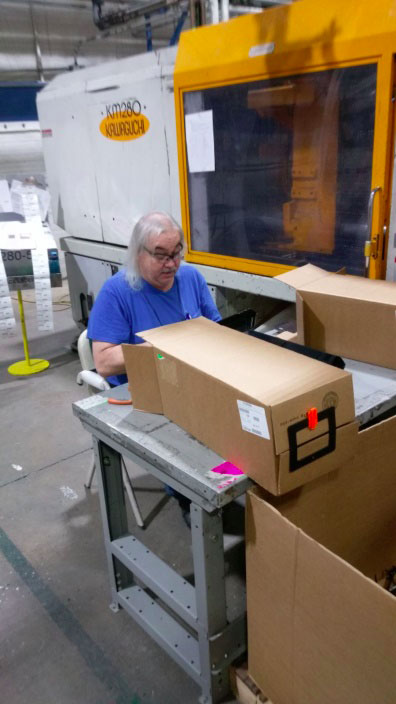
Figure 1
Loading Newly Molded Plastic “Wings” Into Unique, “End Opening” Boxes.
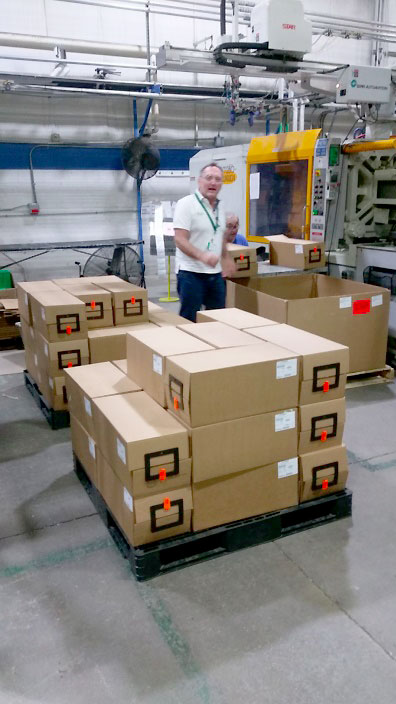
Figure 2
Palletizing the Filled Boxes After Closing With Latches on Both Ends
This process allows for storage in a manner that prevents contamination of contents and allows for the correct ergonometric access to parts in proper position for simple and swift removal by our assembly cell work force.
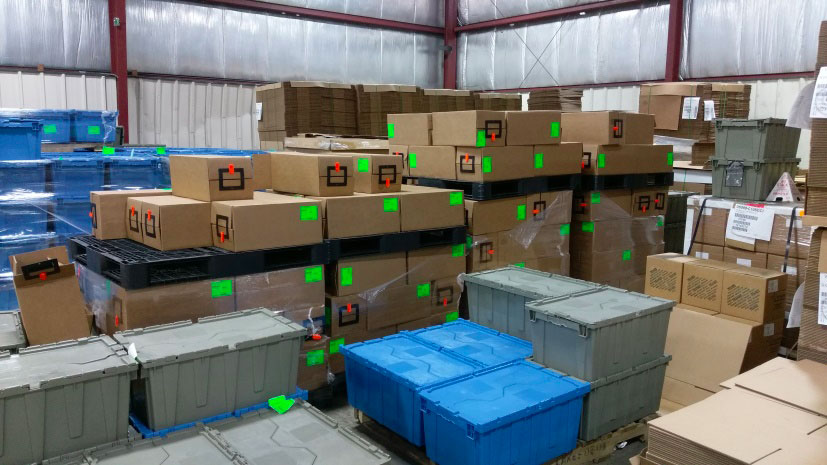
Figure 3
Palletized, Filled Boxes Closed By Box Latches™ with Anchors On Both Ends.
How Things Work At the Assembly Cells
It is at this point where the benefits derived from this system explode. As can be seen in Figures 4 & 5, improvements in the entire assembly cell set‐up at WPI allows boxes and totes to be easily loaded into and replenished from the back of the cells.
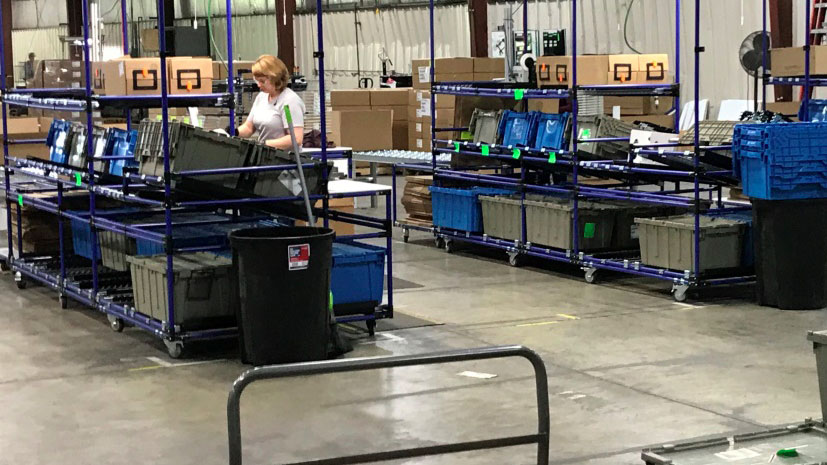
Figure 4
Three of the Now Ten Assembly Cells – Down from Original Sixteen
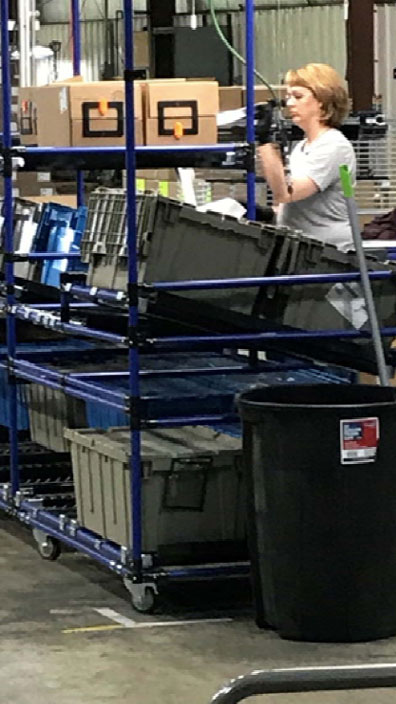
Figure 5
Assembly Cell Illustrating Boxes Closed By Box Latches™ With One Anchor At Each End Instead of Tape
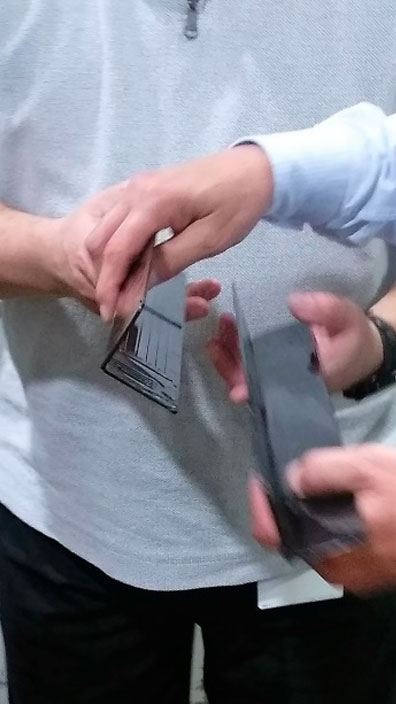
Figure 6
The Long, Black Plastic “Wing” That Is Loaded Into the Latched Boxes
Increased Floor Space
As seen in Figures 7 and 8, when latched boxes are emptied, they are flattened with latches left in place, moved back to the starting point in the facility and reconstructed. This system eliminates cutting tape before flattening boxes and the need to find the tape gun and reapply tape when reconstructing them. Perhaps even better, it saves boxes, floor space and massive amounts of time, labor and occasional human injuries from box cutters.
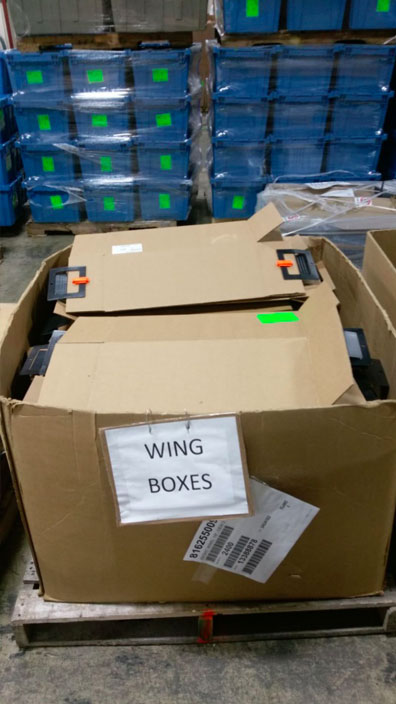
Figure 7
Deconstructed Boxes Ready for Reconstruction Without Tape
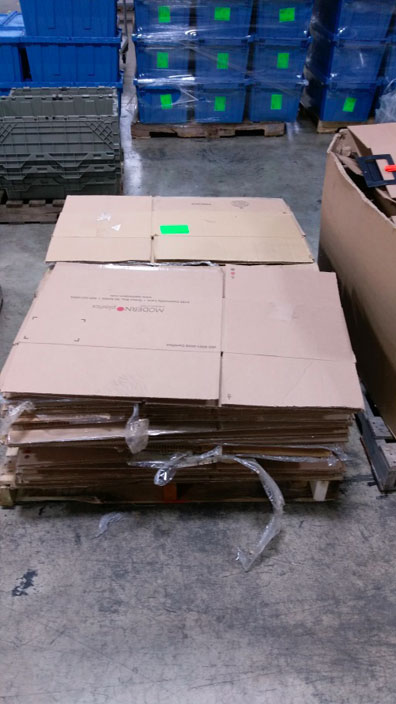
Figure 8
Deconstructed Boxes With Tape Fragments Everywhere
WPI will soon have data and/or additional photos illustrating the amount of floor space that is saved by collapsing the empty corrugate boxes rather than storing the expensive, empty plastic totes. They already know the following:
- Totes when emptied get put on a pallet in three stacks of 18 = 54 per pallet; this stack is over 5 feet high.
- At present they are putting roughly 150 flattened boxes with the Box Latches™ still attached in half Gaylords and can double stack those (loose packed, they can probably squeeze even more in)
- So, they get nearly 300 empty, flattened boxes in the same floor space as 54 empty totes.
Additional Productivity Benefits
Increased productivity gained by all they have done with the new assembly system implemented over the past few months is reflected below in Carl’s statements below:
- We reduced the number of assembly stations from 16 down to 10 and have nearly doubled our throughput per line in the process.
- The boxes closed with Box Latches™ enable our Water Spider [restocker] to quickly and efficiently replenish parts through the back of the assembly cells ready for box opening by assemblers positioned at the front of the stations without the need for a box knife.
- Using neon green latches on 1% of the boxes with the rest closed with black, we are tracking box reuse and already know that after 3‐4 uses, the boxes still look good.
- We use between 385 and 500 bins [boxes and totes] of materials per day, which means that 7‐10 pallets of empty bins rotate through our facility daily. That adds up to a lot of space and labor.
- So, while our direct labor is super‐efficient, it comes at a price, one that would be even higher if we hadn’t chosen the Box Latch™ option.
- Equally impressive, reducing the floor space occupied by plastic totes created free space for other uses. At $20/sq ft, that produces a very hefty side benefit.
Conclusion
After a year of using the Box Latches with anchors, WPI is on the 16th round trip using their original, expensive custom made boxes. Carl reported the following in August of 2019, “My team and I are saving $10,000 to $12,000 per year on boxes ‐ without having to purchase any additional latches with anchors.” Because of ever expanding business demands, WPI also is saving an unknown amount of money on tape while reducing labor costs and freeing up floor space for other uses.
